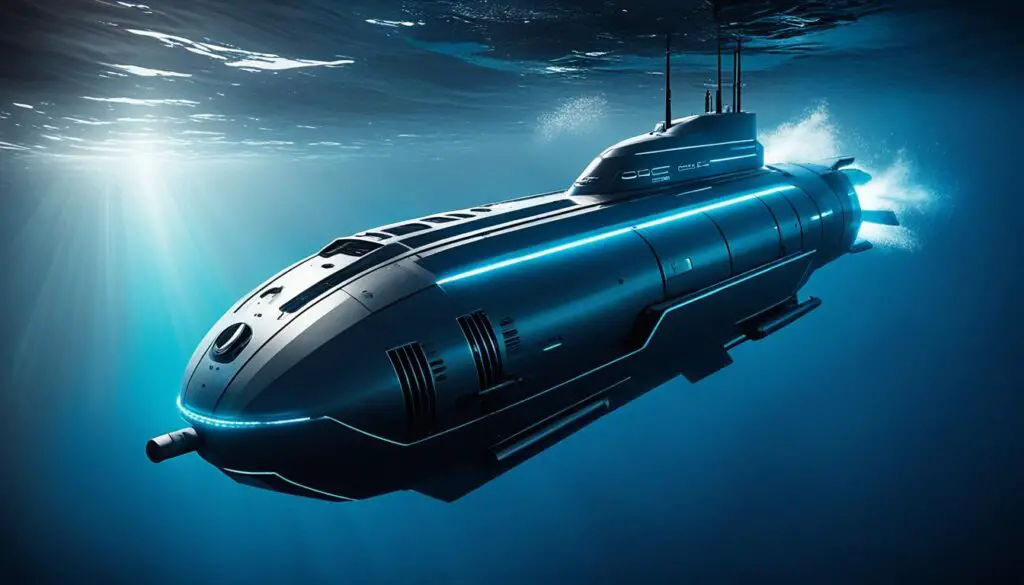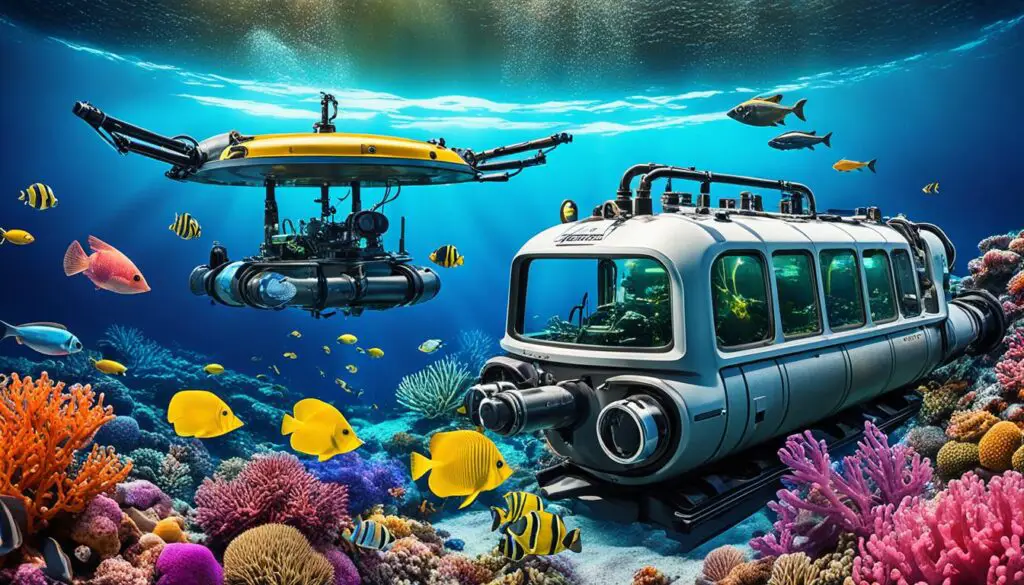As an avid enthusiast of underwater exploration, the mesmerizing vastness of the ocean depths has always fascinated me. It is a world that holds countless mysteries and wonders, waiting to be unveiled. That’s why the advent of submersible vehicles has been a game-changer in the field of underwater exploration.
Submersible vehicles serve as advanced tools that enable researchers and explorers to dive into the unseen realms beneath the ocean’s surface. These innovative vehicles are specifically designed to withstand the immense water pressure and extreme conditions found in the ocean depths, allowing them to explore and study uncharted territories like never before.
Equipped with state-of-the-art technology, including sonar systems, cameras, and sampling equipment, submersibles capture valuable data and images from the deep sea. They play a crucial role in discovering new species, studying marine ecosystems, and investigating underwater geological formations.
The development of submersible vehicles has revolutionized our understanding of the underwater world. With each dive, scientists unravel the mysteries hidden beneath the surface, expanding our knowledge of the delicate balance of life in our planet’s oceans.
Key Takeaways:
- Submersible vehicles enable exploration of the ocean depths like never before.
- They are designed to withstand high water pressure and extreme conditions.
- Equipped with cutting-edge technology, submersibles capture valuable data and images.
- They contribute to discoveries of new species and the study of marine ecosystems.
- Submersible vehicles revolutionize our understanding of the underwater world.
The Advancements in Submersible Technology
Over the years, significant advancements have been made in submersible technology, enhancing the capabilities and efficiency of these vehicles. Modern submersibles are equipped with more powerful propulsion systems, allowing for faster and more streamlined dives. Remotely operated vehicles (ROVs) and autonomous underwater vehicles (AUVs) have become increasingly popular, reducing the need for human presence in hazardous deep-sea environments.
ROVs and AUVs are equipped with sophisticated sensors and cameras, providing real-time data and high-quality imagery for scientific research and exploration purposes. The use of advanced materials, such as titanium alloys, has improved the durability and strength of submersible vehicles, enabling them to withstand the immense pressure at great depths. Submersible technology has also allowed for the development of specialized vehicles, such as deep-sea research submarines and robotic explorers, capable of reaching extreme depths and exploring challenging underwater terrains.
| Advancements | Description |
|---|---|
| Powerful propulsion systems | Allow for faster and more streamlined dives |
| ROVs and AUVs | Reduce the need for human presence in hazardous deep-sea environments |
| Sophisticated sensors and cameras | Provide real-time data and high-quality imagery |
| Advanced materials like titanium alloys | Improve durability and strength |
| Specialized vehicles | Capable of reaching extreme depths and exploring challenging terrains |

Unveiling the Wonders of the Deep Sea
Submersible vehicles have revolutionized deep-sea exploration, unlocking a spectacular world brimming with intricate marine life and hidden treasures. Through daring submersible expeditions, scientists and researchers have made remarkable discoveries, shedding light on the mysteries that lie beneath the ocean’s surface.
One of the most awe-inspiring aspects of these expeditions is the revelation of new species and the revelation of ecosystems that were previously unknown. The deep sea is a richly diverse realm, home to unique organisms with extraordinary adaptations. Submersibles have provided an unprecedented opportunity to witness and document this astonishing biodiversity, unraveling the complexities of underwater life.
Exploring the depths with submersible vehicles has also unveiled mesmerizing underwater geological formations. Hydrothermal vents, for instance, are volcanic cracks on the ocean floor that release mineral-rich, scalding water, creating otherworldly ecosystems. Submersible expeditions have allowed scientists to witness and study these fascinating ecosystems firsthand, deepening our understanding of the interconnectedness of life in the depths.
“Every dive into the deep sea is like stepping into a portal of discovery, revealing hidden wonders and adding pieces to the puzzle of life on our planet.”
Moreover, submersible expeditions have contributed to our understanding of climate change and its impact on the oceans. By collecting data on ocean temperatures, currents, and other environmental factors, these missions have provided crucial insights into how our planet is responding to global warming. This information is vital for developing effective conservation strategies and sustainable management of marine resources.
As technology continues to advance, submersible vehicles will play an increasingly pivotal role in further unraveling the mysteries of the deep sea. With their ability to navigate extreme depths and harsh conditions, they are indispensable tools for scientists and explorers. Through the lens of a submersible, we gain a deeper appreciation for the fragility and beauty of our oceans, and the urgent need to protect and preserve this extraordinary ecosystem.

A breathtaking glimpse of the diverse underwater life revealed through submersible expeditions.
Conclusion
In conclusion, submersible vehicles have revolutionized our understanding of the depths of the ocean. Through their advanced technology and capabilities, these vehicles have enabled researchers and explorers to navigate and study the underwater world like never before. Submersibles have played a crucial role in discovering new species, studying marine ecosystems, and exploring underwater geological formations.
The advancements in submersible technology have been remarkable, with more powerful propulsion systems, remotely operated vehicles, and the use of advanced materials. These advancements have enhanced the efficiency and durability of submersible vehicles, allowing them to withstand the extreme conditions of the deep sea.
Unveiling the wonders of the deep sea, submersible vehicles have revealed a world full of diverse marine life, unusual adaptations, and mesmerizing geological formations. They have also contributed to our understanding of climate change and provided valuable data for conservation efforts and the sustainable management of marine resources.
As technology continues to evolve, submersible vehicles will continue to play a pivotal role in further exploring and protecting the fragile ecosystems of the deep sea, unraveling the mysteries and pushing the boundaries of underwater exploration.
FAQ
What are submersible vehicles?
Submersible vehicles are advanced underwater exploration tools used to venture into the unseen ocean depths.
How do submersible vehicles enable underwater exploration?
These innovative vehicles allow researchers and explorers to navigate and study the underwater world like never before.
What are submersibles designed for?
Submersibles are designed to withstand high water pressure, enabling them to dive to great depths and withstand extreme conditions.
What technology do submersibles use?
They are equipped with state-of-the-art technology, including sonar systems, cameras, and sampling equipment, to capture data and images from the deep sea.
What role do submersible vehicles play in exploration?
Submersible vehicles play a crucial role in discovering new species, studying marine ecosystems, and exploring underwater geological formations.
How have submersible vehicles revolutionized our understanding of the underwater world?
The development of submersible vehicles has revolutionized our understanding of the underwater world and continues to push the boundaries of exploration.
What advancements have been made in submersible technology?
Over the years, significant advancements have been made in submersible technology, enhancing the capabilities and efficiency of these vehicles.
What are remotely operated vehicles (ROVs) and autonomous underwater vehicles (AUVs)?
Remotely operated vehicles (ROVs) and autonomous underwater vehicles (AUVs) have become increasingly popular, reducing the need for human presence in hazardous deep-sea environments.
What are the features of ROVs and AUVs?
ROVs and AUVs are equipped with sophisticated sensors and cameras, providing real-time data and high-quality imagery for scientific research and exploration purposes.
How have materials improved the durability of submersible vehicles?
The use of advanced materials, such as titanium alloys, has improved the durability and strength of submersible vehicles, enabling them to withstand the immense pressure at great depths.
What specialized vehicles have been developed using submersible technology?
Submersible technology has allowed for the development of specialized vehicles, such as deep-sea research submarines and robotic explorers, capable of reaching extreme depths and exploring challenging underwater terrains.
What discoveries have submersibles made in the deep sea?
Submersible vehicles have led to remarkable discoveries in the deep sea, unveiling a world teeming with diverse and fascinating marine life.
What have submersibles revealed about underwater ecosystems?
Researchers have encountered new species, unusual adaptations, and ecosystems that were previously unknown.
What geological formations have been discovered through submersible expeditions?
Exploration expeditions using submersible vehicles have revealed mesmerizing underwater geological formations, such as hydrothermal vents and underwater volcanoes.
How do submersibles contribute to our understanding of climate change?
These expeditions have also contributed to our understanding of climate change by collecting valuable data on ocean temperatures and currents.
Why are submersible missions important for conservation efforts?
The data and findings obtained from submersible missions are vital for conservation efforts and the sustainable management of marine resources.
How will submersible vehicles continue to impact underwater exploration?
As technology continues to advance, submersible vehicles will play a pivotal role in further exploring and protecting the fragile ecosystems of the deep sea.
